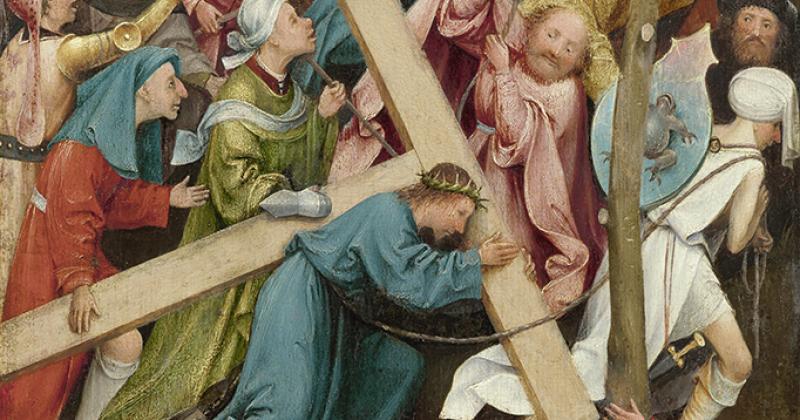It’s said that the first person to make the Stations of the Cross was the Blessed Virgin Mary. After her Son ascended into Heaven, everyday she walked the route from the place where Pontius Pilate condemned Jesus to death, through the streets of Jerusalem, outside the city walls to Calvary where he was crucified, and then to Joseph of Arimathea’s tomb where she and a tiny handful of Christ’s friends buried him.
It’s a lovely thought, a lovely story, but it’s only that—a lovely story.
We don’t know when Christians began to visit the sites associated with what we call the Way of the Cross. It’s possible that it predates 313, the year Emperor Constantine published the Edict of Milan, which not only granted liberty to the Church but actively favored it.
The earliest surviving document to mention the Way of the Cross devotion is the account of Egeria, a Spanish nun who made a lengthy tour of the Holy Land in the early 380s and wrote about her experiences there in a manuscript known as Peregrinatio ad loca sancta, or A Pilgrimage to the Holy Places. Egeria followed the route, but from her description it appears that it was entirely a private devotion. It was not led by any member of the clergy, there were no prescribed prayers recited at each site (the term “station” hadn’t come into use yet), nor were any hymns sung along the way. A pilgrim walked from place to place, praying and meditating on Christ’s last journey as he or she drew closer and closer to the goal of this mini-pilgrimage—venerating Calvary and the Tomb in the Church of the Holy Sepulchre.
We do know that when Egeria visited these holy place, probably she was not alone. In 386, St. Jerome, who had retired from Rome to Bethlehem to complete his translation of the Bible, tells us that throngs of pilgrims from every corner of the Roman world walked the same route Egeria had followed.
Following in the footsteps of Christ proved to be an emotionally and spiritually powerful experience for many of pilgrims, something they made a point of describing to their families and friends when they returned home. Of course, for most Christians a journey to Jerusalem was an expensive, even perilous expedition that the overwhelming majority would never make. So, St. Petronius, the bishop of Bologna in Italy, had an inspiration: at the monastery of Santo Stefano in his city he built a series of small chapels, each one inspired by one of the shrines in Jerusalem. Members of his diocese and Christians from farther afield came to Santo Stefano to pray in each chapel in turn. It was St. Petronius, then, who established the tradition of setting up Stations of the Cross in parish churches.
How we arrived at 14 stations is an open question. There was enormous variety in the stations over the centuries and in various places. Some churches only had seven, and these were dedicated to the Seven Sorrows of Our Lady rather than events from Christ’s Passion. In the 1400s, a pilgrim to Jerusalem asked some Franciscans in the Holy City how many stations were to be found there. They replied there were 32. Even today, some parishes have added a fifteenth station in honor of Christ’s Resurrection. And there are also Scripture-based Stations of the Cross that only features events found in the Passion narratives in the gospels. This means that the station of St. Veronica wiping the face of Jesus is out. On a personal note, that’s always been my favorite station, so at the risk of offending the biblical scholars, I’ll stick with the traditional 14.
One of the joys of the Stations of the Cross is that it is both an active and a contemplative devotion. It’s active because whoever is making the stations walks from scene to scene; it is contemplative because the purpose of the devotion is to meditate on the sufferings Our Lord endured to redeem the world. All around the Catholic world, at shrines especially, it’s commonplace to find stations erected on a hillside, where the devout must exert a little more physical effort to follow in the steps of Christ. In some places at least, the active element is almost athletic.
Walking and meditating is still all that is required to make the Stations of the Cross (although invalids and the disabled are dispensed from the requirement to walk from station to station). If your parish offers Stations of the Cross on Fridays during Lent, you remain in your pew while the priest and the servers (if there are any) walk from station to station on behalf of the congregation.
Over the centuries priests, nuns, and laypeople have recommended prayers and hymns for the devotion, and published meditation guides to help individuals keep their mind focused on the sufferings of Christ. If you own a meditation guide for the station, it is most likely the one written by St. Alphonsus Liguori (1696-1787)—his is the most common. The hymn most often sung during Stations of the Cross is “At the Cross Her Station Keeping,” a translation of “Stabat Mater,” the fourteenth-century hymn written originally for the Feast of Our Lady of Sorrows but adopted for the Stations because the verses fit perfectly.
Holy Mother! pierce me through;
In my heart each wound renew
Of my Saviour crucified.
The prayer most often recited at the stations is, “We adore thee O Christ and we bless thee, because by thy holy cross thou hast redeemed the world.” By tradition this prayer is recited at each station.
The prayers and hymns and suggested meditations are lovely and undoubtedly enhance the experience of praying this devotion, but they are not necessary. All one needs to do is keep moving from station to station and keep your mind fixed on Christ’s Passion.
